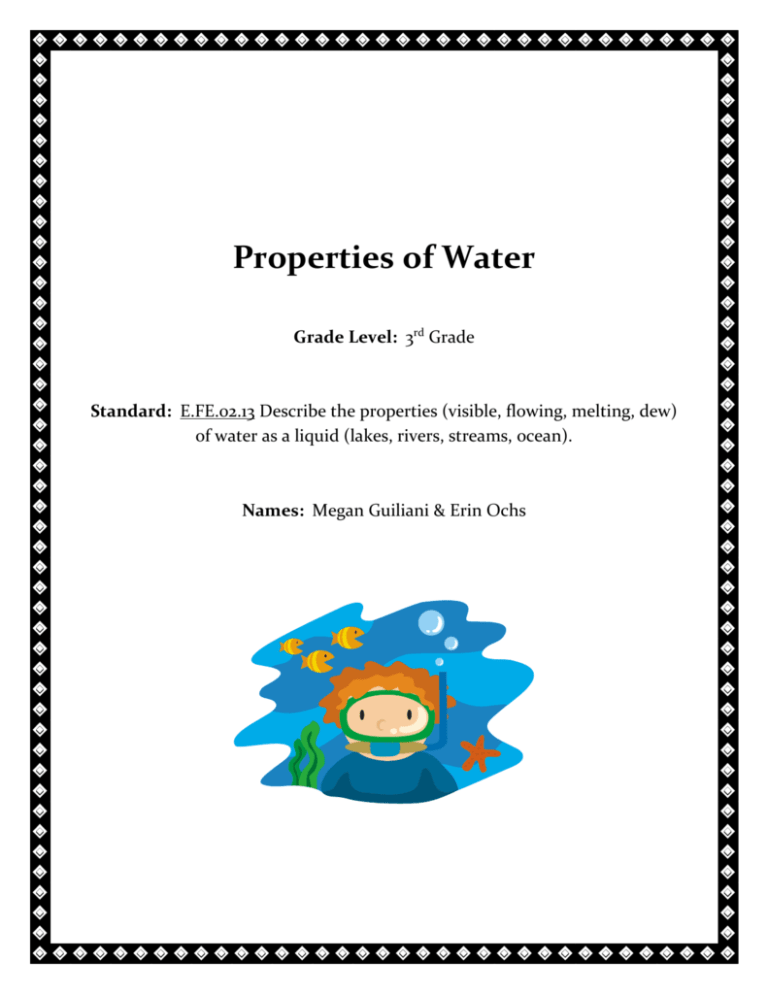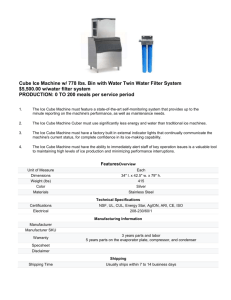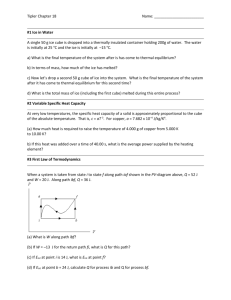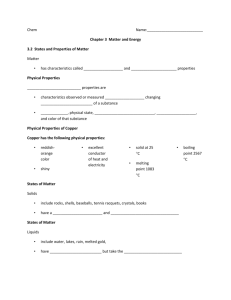E.FE.02.13 Win 08
advertisement

Properties of Water Grade Level: 3rd Grade Standard: E.FE.02.13 Describe the properties (visible, flowing, melting, dew) of water as a liquid (lakes, rivers, streams, ocean). Names: Megan Guiliani & Erin Ochs THE TEACHING PROCESS Lesson Overview After completion of the lesson, students will be able to: Describe the properties of liquid water as visible, flowing, melting, and dew. Define what are streams, rivers, lakes, and oceans. List of Materials: For Visuals Water Cup Ice Foil Pitcher 2 Straws Pan Other Properties of Water Worksheet Water as a Liquid Worksheet Flip Book Pencils Crayons for Each Student Scissors Stapler Staples Phase One: Engage the Learner A water bottle will be passed out to each student in the class. While they enjoy a fresh sip of water they will be asked, “What are you drinking?”, “What is water to you?”, What is your definition of water?” , “Where else do you see water; does it just come in bottles?” This will begin a class discussion of water. Phase Two: Explore the Content ~ Demonstrations ~ - Students may need to get out of their seats to get closer to demonstrations done by the teacher - Visible: A glass of water and ice will be presented to the class to explain that this is visible water; it is water that you can see. As a class, we will discuss where we visible water is presented in our everyday life. We will make a list as a class brainstorming ideas. Examples: rivers, lakes, ocean, rain, pool, puddle, ice cube, class of ice, coming out of a faucet, bathtub, etc. It will then be mentioned but not explained in depth that there is water in the air that is so tiny that you can not see it, but it is there. Flowing: For the first demonstration of flowing water, the materials that will be needed are a pitcher, a bowl, aluminum foil, and water. It will be explained to the class that water as a liquid can flow (unlike when it is a solid). It will be discussed as a class where flowing of water can be found. Some examples may be: stream, river, ocean, lake, rain down on a window, out of a faucet, etc. It will be explained that water flows down mountains. To show this, there will be a bowl on the table. The aluminum foil will be held at an angle over the bowl while water from the pitcher is being poured out onto the foil, flowing into the bowl. The foil represents the mountain sides. Once the students see the flow of the water down the “mountain side” it will be explained to the class that water flow can move around big objects in its way and move little objects. To show that water can flow around objects, an object will be placed on the foil where the water is flowing. They will then be able to see that the water does not stop, but continues to flow around the object. For the second experiment, materials needed are straws, water, and a pan. Fill the pan up with water. It should be explained to the class that even though lakes and oceans are a big body of water and do not move from one location, water is still flowing. We can see the flow of lakes and oceans by the waves. To demonstrate this, use a straw to blow on the water in the pan. The water will make ripples, representing waves in a body of water. Melting: It will be explained to the class that water presented in a solid can be melted to a liquid. Melting occurs when the temperature of the solid water is cooler than its surroundings. The demonstration for melting will involve all the students. Each child will get their own ice cube and place it into their hand. They will be told to close their hands, holding the ice cube so that it is fully covered. It will be discussed with the students that the ice cube feels colder than their hand because their hand is at a higher temperature then the ice. After holding the ice cube in their hands for awhile the ice cube will begin to melt. As it melts water will begin to drip from their hands. It will be explained that this water is the ice melting. The ice cube will continue to get smaller and eventually all turn into water. There will also be an ice cube placed on a plate infront of the class to come observe over time. This will show the students that the ice turns into water in a liquid form. Since the water may drip down their arms as the ice cube disappears, the ice cube on the plate will clear up confusing on the ice cube and water disappearing. The class should discuss where they can find water that will melt. Some examples of this can be: ice cube, snow, icicles, iceberg, etc. Dew: This experiment will consist of a glass of water and ice cubes. The ice cubes should be placed in the room temperature glass of water. Let it sit for a little while. Just like the melting experiment, the students should come back to check on the glass. Over time water will begin to form on the outside of the glass. It will be explained to the class that the cold liquid inside cools the air near the outside surface of the glass. Moisture on the outside of the glass begins to form into a liquid. This is why a cold glass of water, tea, or lemonade on a hot summer day seems to be “sweating”. Examples of this should also be discussed with the class. Some examples discussed may be: on a cold glass on a hot summer day, taking a container out of the freezer, water on a car in the morning, water on the ground/grass in the morning, etc. Phase Three: Explain the Concept and Define the Terms Once all the demonstrations have been presented the students should return to their seats for a class discussion. In the class discussion the students should be introduced more in depth with the terms used to understand the properties of water as a liquid. Terms to be discussed: Visible: This is water that can be seen with the human eye. Flowing: Water that is moving in one direction. Down a mountain. Waves toward shore. Melting: Water that turns from a solid to a liquid. Dew: Water in the form of in small drops that cling (stick) to objects. Stream: A flow of water smaller than a river. River: A flow of water bigger than a stream (water usually flows faster in a river than stream). Lake: Large body of water, usually fresh water. Smaller than oceans. Ocean: Large body of salt water that covers 70% of the earth. Larger than lakes. During this stage the students will fill out their vocabulary sheet of the properties of water as they are discussed with the class. Phase Four: Elaborate the Concept Stage five will be presented with the students completing the Water Properties worksheet packet. This worksheet contains five pictures of different properties of water. They are to color the water blue and on the line provided next to each picture write what phase the water is in; visible, flowing, melting, or dew. There is a map page included in this packet. With this worksheet, the students will identify lakes, livers, and oceans with different colored crayons. Phase Five: Evaluate students' Understanding of the Concept During phase four students will be creating a Flip Book of the liquid properties of water. The Flip Book has each property discussed in class (visible, flowing, melting, and dew) labeled at the bottom of each page. Then on the lines provided above the term they will write the definition of each term in their own words. They then will draw a picture of each vocabulary term above the definition. They will be given time in class to work on this project. They will be aloud to discuss their Flip book with other classmates in the process of making the book. They will also share their flipbooks in a group of 3, sharing the definitions of the properties of water they put in their own terms along with sharing their drawings. References: Meek’s Guides: Dew Point Experiments http://www.astroscan.net/satelloid/experiments/weather/dew_point_experiment.pdf Free Printable Coloring Pages: http://freeprintablecoloringpages.net/ Scholastic: Fill-in Flip Books for Grammar, Vocabulary, and More (Grades 3-5) By: Michael Gravois What’s the Weather? Scholastic- Illustrated by: Jo Moon








